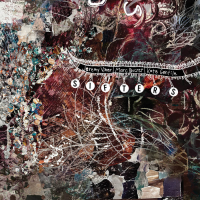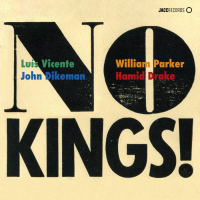Home » Jazz Articles » Album Review » Hal Galper: Cubist
Hal Galper: Cubist
Yet in the new century, Galper has turned the piano trio concept on its collective ear, something that hadn't taken place in the jazz universe since Bill Evans entered the fray with his conversational approach to the trio with Scott LaFaro, and Paul Motian. Galper has pushed the boundaries of the music in his distinct rubato style, an open and interpretive concept of time where the musical continuum achieves a high degree of elasticity. Galper has found the perfect partners in this reshaping of the art form in trailblazing bassist Jeff Johnson and sophisticated intuitive drummer John Bishop. The trio has found a home at Origin records, now a legacy of six albums beginning with the 2007 release Furious Rubato (Origin, 2007).
On his new release on Origin, Cubist, Galper expands his vision to the quartet, bringing in long time colleague and friend, tenor saxophonist Jerry Bergonzi. Bergonzi adds yet another dimension to the rubato equation, adding avenues of collective insight that fits in seamlessly with this trio that has achieved such a rare subconscious understanding of each other. Recorded in an open session format before a small audience, the music has an overwhelming emotional honesty, and visionary artistry. The quartet seems to match musical character and personality perfectly between the four participants.
Bassist Jeff Johnson, long one of the most musical of jazz bassists, contributes four compositions that define his unique approach to writing. His conception of time and space is uniquely compatible to Galper's vision of the same. Johnson has played in Galper's trio since the early 90's, and has submitted a number of tunes to him in the process, most of which going unrecorded. For this session, some of them 'clicked,' including the aptly titled "Cubist." States Galper, "It struck me how apt the title was, how our Rubato Style is similar to Cubist painting." Indeed, the metaphor is striking, the visual concept of all the elements being there, yet with many of them out of place, and emphasized in different variables.
"Scene West" conjures audible snapshots of Johnson's solo recordings, in particular the eclectic The Art of Falling (Origin, 2001). Johnson leads his partners into the fray with a dark, rhythmic undercurrent that results in a free, tumbling whirlwind of a solo from Galper. Bergonzi adds a restrained subtlety to the conversation that builds into an urgent frenzy, in the end dropping off into Johnson's deeply colored melodicism.
There is a certain radiant tonality to the playing of drummer John Bishop. Indeed, as in many ways that one might describe these same tonal qualities in a horn player, Bishop has his own distinctive sound, one that a listener can identify on any recording. His intuitive sensitivity, chant-like use of cymbals, and masterful brush work serve as a spatial touchstone throughout Cubist. His long term artistic relationship with Johnson predates his association with Galper, and those qualities that can only be chanced upon over time shine brightly when merged with Bergonzi's full bodied dynamic articulation, and Galper's visionary freewheeling conception of time.
Galper's original, "Scufflin" highlights his innovative processes as a pianist. His lightning quick fluidity, melodic phrasing, and ability to move the music, and reactions of his bandmates in variable directions at will, are astoundingly unique to his gigantic talents. Throughout the linear historic timeline of great jazz pianists, Galper undoubtedly falls along the lines of Duke Ellington, Bill Evans, Bud Powell, and Ahmad Jamal in terms of their approach to intimate trio playing.
After six albums together on Origin, Galper could have very well chosen to sustain the momentum with his mates Johnson and Bishop, continuing to record and tour as a trio. The addition of Bergonzi turns out to be another stroke of collective genius for Galper, and his forward moving approach to modern jazz music. His playing from start to finish on this record is truly transformative. It states clearly his ability as a leader to value the whole greater than the collective parts. The result is a compelling rubato experience for the listener.
Much is mentioned here, and in every subsequent review of his recordings over the past decade, of the advanced conception of time utilized by Galper. It must be stated that while the music may often travel in uncharted territory, it nonetheless travels in the same universe where the jazz tradition resides, where an elastic sense of freedom can ground itself in swing, and the finer qualities of post bop free thinking. Galper has found the perfect four personalities to travel through this musical labyrinth with. All four have emerged from past histories with jazz legends to bushwack a trail through the never ending expedition into musical exploration and discovery. On Cubist, they have revealed a work of true artistic mastery, and generational significance. In many ways, it personifies the direction of jazz music into the 21st century, a mantle to be grasped and moved forward by generation next.
Track Listing
Solar; Israel; Artists; Kiwi; Cubist; Scene West; In A Sentimental Mood; Scufflin'.
Personnel
Hal Galper
pianoHal Galper: piano; Jerry Bergonzi: tenor sax; Jeff Johnson: bass; John Bishop: drums
Album information
Title: Cubist | Year Released: 2018 | Record Label: Origin Records
Tags
PREVIOUS / NEXT
Support All About Jazz
 All About Jazz has been a pillar of jazz since 1995, championing it as an art form and, more importantly, supporting the musicians who make it. Our enduring commitment has made "AAJ" one of the most culturally important websites of its kind, read by hundreds of thousands of fans, musicians and industry figures every month.
All About Jazz has been a pillar of jazz since 1995, championing it as an art form and, more importantly, supporting the musicians who make it. Our enduring commitment has made "AAJ" one of the most culturally important websites of its kind, read by hundreds of thousands of fans, musicians and industry figures every month.




















